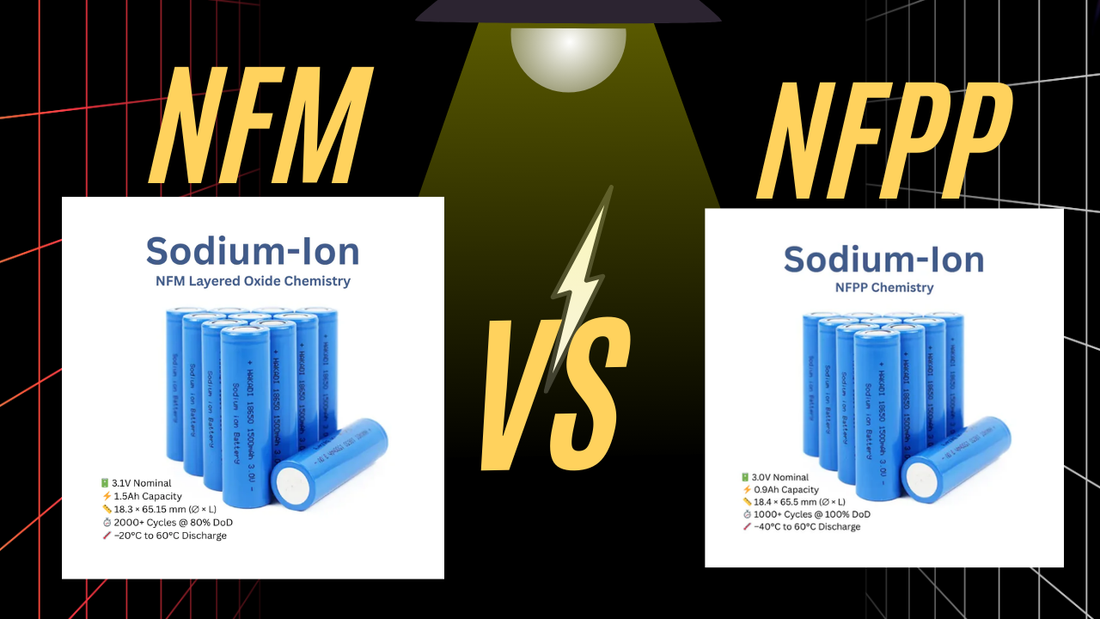
NFPP vs NFM: Which Sodium-Ion Chemistry Is Best for you?
Share
Sodium-ion batteries are quickly emerging as a cost-effective alternative to lithium-ion—especially for stationary energy storage systems. Among the various sodium-ion chemistries, two stand out:
- NFPP (Sodium Iron Pyrophosphate)
- NFM (Sodium Iron Manganese Oxide)
While they both rely on abundant and inexpensive materials, they differ significantly in performance characteristics. Here’s what you need to know if you're evaluating these chemistries for off-grid, grid-tied, or commercial energy storage applications.
📚 Want a more general intro to sodium-ion batteries? Read my earlier post here.
⚗️ The Basics: What Are NFPP and NFM?
- NFPP (Na₄Fe₃(PO₄)₂P₂O₇) is a polyanionic cathode similar to lithium iron phosphate (LFP). It emphasizes safety, thermal stability, and very long cycle life.
- NFM (commonly NaFe₁₋ₓMnₓO₂) is a layered oxide cathode, closer in behavior to NMC (nickel manganese cobalt) cells. It’s tuned for higher energy density but with tradeoffs in thermal stability and lifespan.
🔬 Key Performance Comparison
| Attribute | NFPP Sodium-Ion | NFM Sodium-Ion |
|---|---|---|
| Nominal Voltage | ~3.0 V | ~3.1–3.3 V |
| Voltage Range | 1.5–3.7 V (typical) | 1.5–4.1 V (varies by doping) |
| Gravimetric Energy Density | ~90–120 Wh/kg | ~130–160 Wh/kg |
| Cycle Life (80% capacity) | 6,000–10,000 cycles | 1,500–3,000 cycles |
| Thermal Runaway Threshold | >300 °C | ~200–250 °C |
| Operating Temp Range | –20 °C to +60 °C (some cells –40 °C to 80 °C) | 0 °C to ~45 °C |
| Raw Materials | Sodium, Iron, Phosphate | Sodium, Iron, Manganese |
| Safety Profile | Extremely stable, abuse-tolerant | Moderate—risk of thermal runaway under abuse |
| Application Suitability | Stationary storage, especially in harsh climates | EVs, scooters, or storage where space is limited |
🧠 What This Means in Practice
If your system prioritizes safety, longevity, and thermal tolerance (think desert or polar installations), NFPP is the clear winner. You can cycle it multiple times a day, install it in less-controlled environments, and expect it to last a decade or more with minimal degradation.
But if your constraint is space or weight, and you're okay with tighter thermal management and shorter lifespan, NFM offers better energy density—making it potentially more viable in EVs or compact battery systems.
🛠 Example Products and Use Cases
Looking to source these technologies? OG Solar Store carries NFPP-based sodium-ion cells that are ideal for residential and commercial BESS setups:
👉 Browse sodium-ion batteries on OGsolarstore.com
🔋 Bottom Line
- Choose NFPP if your priority is stability, lifetime, and cost-per-cycle.
- Choose NFM if you're chasing energy density and can accept the tradeoffs.
In the late 2020s, expect to see NFPP dominating stationary storage markets, while NFM and other high-voltage chemistries jockey for space in the EV world.
🎥 Coming Soon on YouTube
I’ll be breaking this topic down further in an upcoming video—where I’ll compare real-world use cases, show test data, and walk through why NFPP is getting serious traction in grid storage projects.
👉 Subscribe to SolarJoeJoe on YouTube so you don’t miss it.
